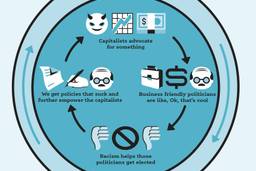The Secret Lives of Plutocrats
In Richistan, Robert Frank offers a breezy, well-observed peek into this gated community. You too could visit if you graduate from “butler boot camp” and become a $120,000-a-year “household manager”
David Moberg

Ed Bazinet lives in Richistan. He moved there after pocketing more than $100 million from the sale of his company, which peddled miniature ceramic houses made in Taiwan to enthusiastic collectors whose interest Bazinet never understood. (He would disparagingly stamp their gushing letters of appreciation “get a life.”) His more famous neighbors include the Walton family, Microsoft mogul Bill Gates, investor Warren Buffet, and media tycoon Rupert Murdoch.
Where is Richistan? According to Wall Street Journal reporter Robert Frank, it’s the domain – effectively a country more foreign to us than the other “stans” on the map – of the world’s households that are worth $1 million or more. But these 9 million-plus households, which have more than doubled in number over the past decade, actually are further divided into distinct provinces of Lower, Middle and Upper Richistan, as well as Billionaireville – population 400 and growing.
In Richistan (Crown), Frank offers a breezy, well-observed peek into this gated community. You too could visit if you graduate from “butler boot camp” and become a $120,000-a-year “household manager,; overseeing one of the several far-flung homes and extensive staffs of any Richistani who qualifies as really rich by having a fortune of $10 million or more. Each year the richest half percent of American households – around 730,000 families – spend about as much as all Italians combined – about 24 million households. And even as many Richistanis insist they’re really simple, middle-class folks, they indulge in competitive consumption of 500-foot yachts (with such amenities as basketball courts, submarines, stripper poles and helipads), $736,000 watches and art collections to fill their 70,000-square-foot mansions.
Not since the ’20s, before the Depression and New Deal laws compressed incomes, has wealth been so concentrated at the top in the United States. The old rich increasingly are swamped by new multimillionaires who were founders or executives of companies that went public or were acquired by another company, lavishly compensated corporate chief executives, or “money movers,” such as the hedge fund and private equity managers now making more than $1 billion a year. By Frank’s reckoning, they’re a diverse lot, who are not always happy with their wealth nor respected by their peers. Some continue pursuing wealth and power; others promote novel charitable initiatives or even progressive political goals. (Billionaires, he reports, vote more Democratic than mere millionaires.)
The lives of the poor are studied to death, but the rich escape scrutiny. So Frank’s report is a welcome, highly readable glimpse over the walls surrounding Richistan, combined with warnings about the troubling gap between the very rich and everyone else. That gap is likely to widen as the global rich further detach themselves from national roots and identify more with each other. But other than noting that new technologies and financial deregulation contributed to the wealth boom, Frank fails to analyze the political and economic decisions that led to this new inequality, nor does he explore its effects on everyone else. Though an informative, amusing and often infuriating travelogue, Richistan fails to look beyond the veneer of contemporary wealth and power.
Jack Beatty, a senior editor at the Atlantic Monthly, offers a vivid, impassioned account of how the rich triumphed in late 19th century America, and he clearly sees that history as a guide to how contemporary Richistan emerged. In Age of Betrayal: The Triumph of Money in America, 1865-1900 (Knopf), Beatty shows how the rich prospered through a “revolution from above” that betrayed the democratic possibilities for America that were emerging at the end of the Civil War. The promise was reflected in constitutional amendments to free the slaves, extend the franchise, and guarantee equal treatment before the law, as well as Reconstruction’s intended economic transformation of the slave South. But ultimately the North gave up on Reconstruction, failed to fight white terrorism against blacks after the war and abandoned former slaves to worsening, near-slave conditions.
The betrayal went much further: Corrupt politicians and courts provided favors to the men who owned the country’s rapidly expanding big businesses, especially the railroads, granting them the consitutional protections that were intended for citizens. Corporations gained legal recognition as persons by virtue of an inaccurate summary note of a Supreme Court decision in the 1886 case of Santa Clara County v. Southern Pacific Railroad Company, and even after Congress eventually passed antitrust laws, the courts enforced those laws against unions, not corporations.
The revolution from above politically and economically deprived farmers in the West, white and black tenants and sharecroppers in the South, native white and immigrant workers in the East and Midwest. While the frontier beckoned as an escape, Beatty argues it was an illusion: The Homestead Act provided land to less than 400,000 families over three decades, but the rail magnates and land speculators took over huge swaths of public land. Instead, the new order – where farmers confronted falling grain prices, monopoly corporations and tariffs that protected the new industries but raised their costs – drove farmers from the land into factories, or else kept them trapped in impoverished indebtedness producing cotton.
Workers, farmers and sharecroppers fought back, often facing extreme violence, but the rebellion failed. Beatty argues that after the Civil War, both Republicans in the North and Democrats in the South played up sectional antagonisms from the Civil War. Rather than vote according to class issues unleashed by industrialization and laissez-faire capitalism, citizens were diverted by politicans’ appeals to Civil War loyalties. And despite some noble efforts to unite black and white sharecroppers, Southern populism foundered on racism, as well as interneccine squabbles and the U.S. political system’s structural barriers to third parties.
The battle did not end with the defeat of populism. But Beatty portrays early 20th century progressive politics as a watered-down alternative to populism that, in the name of anti-corruption reform, suppressed political activity by lower-income voters. Obviously the New Deal and movements of the ’60s tamed some of the abuses of corporate power and racism, and the United States enjoyed a period of growing equality and prosperity.
Yet the past 35 years have seen a growth of inequality that parallels the period Beatty depicts. Corporations have gained political clout, suppressing unions in more genteel ways than a century earlier but just as effectively. Globalization, imperial ambitions and financial speculation – important factors in the triumph of the rich more than century ago – have played even more influential roles in the new rise of the Richistanis. In the late 19th century, the railroad transformed the economy and created opportunities for huge fortunes. The digital revolution is now playing a similar role (with public subsidies once again contributing to that new wealth). But one of the biggest differences is that there has been no citizen uproar comparable to that earlier period.
Apologists for inequality and concentrated wealth say Americans don’t care, as long as they think they have a chance at wealth. But in Falling Behind: How Rising Inequality Harms the Middle Class (University of California Press), Cornell University economist Robert H. Frank argues that middle-class Americans ought to be concerned about rising inequality because it harms them.
Frank skips over the most obvious harm: According to economists Frank Levy and Peter Temin, the top 1 percent of earners have captured four-fifths of all new income since 1980. A few decades ago that money would have been shared more equitably with the poor and middle class. Frank does note that studies have found that economies tend to grow slower during less egalitarian periods, and this era is no exception.
His key argument, however, is that people make many judgments about their needs within a social context. Whether it’s a hard-wired product of evolution (as Frank thinks) or simply a truism about human social behavior, people everywhere tend to evaluate their needs for housing, food, clothing and other goods in terms of what people around them have. When we have less of these “positional” goods than others, we feel deprived.
For example, many economists believe that people should prefer a 4,000-square-foot home in a world where most people have 6,000-square-foot homes, rather than a smaller 3,000-square-foot home where most other people have a 2,000-square-foot home. But given the choice, most people prefer the house that is bigger than their neighbors’ houses, even if it means having less space. Yet when faced with a similar choice about leisure time, people tend to pick the longer vacation, regardless of what other people have. Leisure is less a “positional” good, that is, judged less by comparison with what others have.
When there’s great inequality of positional goods, like monetary incomes or house sizes, people engage in an “arms race” that ultimately is not only a futile treadmill for most people, but also a distraction from the pursuit of non-positional goods like clean air, a pleasant work environment or leisure. That’s exactly what has happened in the United States, Frank argues. As inequality has increased, rich people are buying bigger homes, which pressures middle-class families to buy bigger homes as well, often so that their children can attend average or better schools. But since their incomes aren’t rising as fast, they work longer hours, go deeper in debt and oppose taxes that cut into their stagnating incomes. They would be better off if there were progressive taxes and regulations that provided more non-positional goods and services (such as health care or mandatory paid vacations), and that reduced inequality.
While no fiery uprising appears to be on the horizon, there are signs of discontent with CEO excess, Bush’s tax cuts for the rich and the financial squeeze on both poor and middle-income families. Even in Arkansas, popular support for a state minimum wage increase last year prompted the legislature to enact it before the local Let Justice Roll movement could put an initiative on the ballot. Organized labor and a group of think tanks are discussing plans for a new campaign against “extreme inequality,” or the roots of Richistan. And issues related to America’s growing class divide are playing an increasingly leading role in the current Democratic presidential primary. Maybe a digital-era populism is finally beginning to take on the most recent age of betrayal.
David Moberg, a former senior editor of In These Times, was on staff with the magazine from when it began publishing in 1976 until his passing in July 2022. Before joining In These Times, he completed his work for a Ph.D. in anthropology at the University of Chicago and worked for Newsweek. He received fellowships from the John D. and Catherine T. MacArthur Foundation and the Nation Institute for research on the new global economy.









